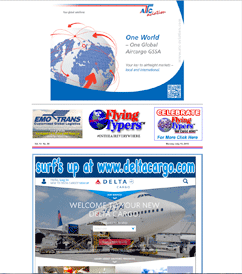
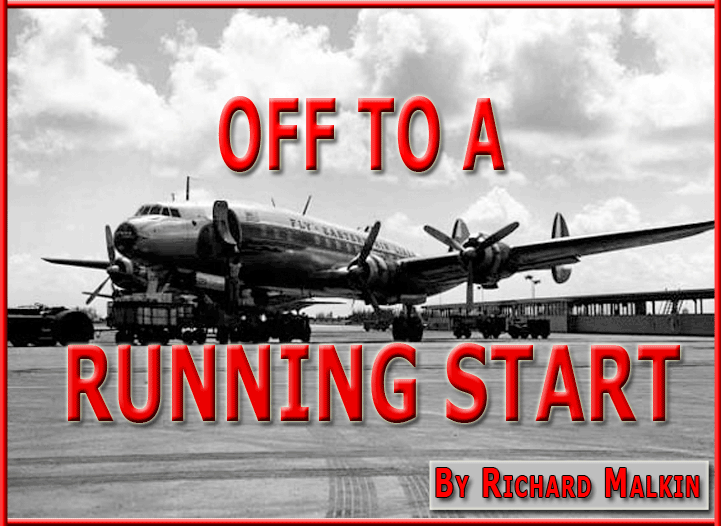
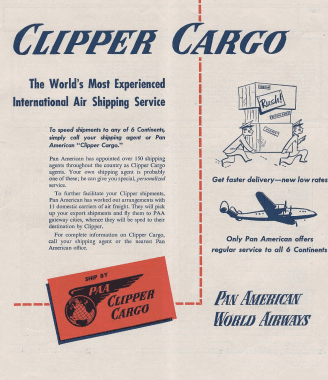 It is an historical caprice
of fate that the closing
of both world wars were
witness in the earlier instance,
to the carriage of newspapers
and mail aboard the first
scheduled airline flight;
and in the later instance,
the dawning of what came
to be known as the Air Cargo
Age (which gave way to the
Jet Era about a quarter-century
afterward).
It is an historical caprice
of fate that the closing
of both world wars were
witness in the earlier instance,
to the carriage of newspapers
and mail aboard the first
scheduled airline flight;
and in the later instance,
the dawning of what came
to be known as the Air Cargo
Age (which gave way to the
Jet Era about a quarter-century
afterward).
I’m
inclined to liken the first
five years of the Air Cargo
Age (1945-50) to a line
of steeds in a wild dash
from the starting gate at
the race park. It was an
incredible burst of speed
toward a broad spread of
envisioned goals, but specifically
the “romance”
of a vital industry aborning.
There
were risks strewn like seeds;
there also were those whose
inner eye encouraged muscular
activity. Imaginations were
in full fling. Wasn’t
it Napoleon who said that
the world is ruled by imagination?
The
first half-decade of the
Air Cargo Age set the stage.
Imaginations were in full
play: hordes of ex-Army
and Navy flyers in air commerce;
established airlines wakened
to a rosier picture of the
shipper as customer; the
spurt in growth and development
of intermediary services;
the rapid expansion of new
products to air distribution’
the swell of interest in
all-cargo availability.
With
the explosive annual rises
in air cargo tonnage and
air cargo ton-miles, it
became a popular sport for
the trade press to ask airline
officials, including air
cargo managers, whether
they believed cargo revenues
would eventually equal passenger
revenues. As one, the airlines
declined to consider the
question. There were, however,
a small number of managers
who privately expressed
optimism in varying degree.
And then there came the
day when Pan Am broke the
ice to become the first
airline to predict officially
that the shipper’s
revenues would equal passenger
revenues in 10 years. TWA
soon followed, holding that
the predicted event would
happen no sooner than 25
years. There is no record
that these venturesome journeys
in prognostication never
occurred again.
What
follows is a spectacular
panorama of examples of
activity in various areas
and on distinct levels that
underscored the mighty thrust
by an infant industry’s
first few years.
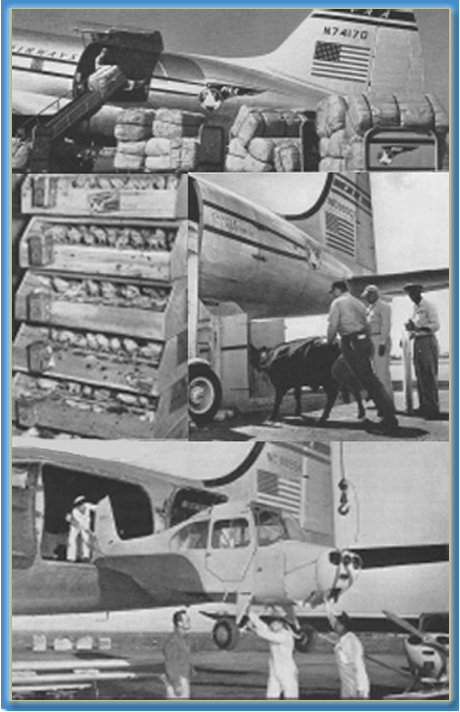 There
is the classic case of the
Four Wheel Drive Auto Co.
of Clintonville, Wisconsin,
with an order for a 7,000-pound
truck to be delivered to
a Cairo-based buyer. Per
schedule, the vehicle was
loaded into a railcar destined
for Newark. But a cable
from Cairo informed the
shipper insisted on delivery
no later than 10 days. Decision
on a quantity order depended
on it. Abrupt change of
plan diverted, upon delivery
in Newark, to a barge crossing
the river and then the truck’s
body was detached from the
cab.
There
is the classic case of the
Four Wheel Drive Auto Co.
of Clintonville, Wisconsin,
with an order for a 7,000-pound
truck to be delivered to
a Cairo-based buyer. Per
schedule, the vehicle was
loaded into a railcar destined
for Newark. But a cable
from Cairo informed the
shipper insisted on delivery
no later than 10 days. Decision
on a quantity order depended
on it. Abrupt change of
plan diverted, upon delivery
in Newark, to a barge crossing
the river and then the truck’s
body was detached from the
cab.
The
machine was trucked across
Manhattan and Queens to
Idlewild Airport. There
a forklift operator took
command and eased the units
of the vehicle in to a DC-4
airfreighter in the service
of Seaboard & Western
Airlines (eventually rechristened
Seaboard World Airlines).
The time was Tuesday, three
days before the inflexible
deadline. With takeoff at
dawn on Wednesday, the aircraft
touched down at Gander and
Shannon, changed crew at
Luxembourg, and onto Rome
and landed in Cairo. Pounding
hearts in Clintonville and
Cairo returned to an even
beat. The result of the
on-time delivery was an
exceedingly pleasant one:
an order for 619 standard
FWTD trucks.
Examples
of heavy lift (and distant
delivery) such as this took
root in many minds, and
the annual reports of the
scheduled and nonscheduled
air carriers underlined
the fact. For a while it
was fashionable for marketers
to claim that any piece
of freight that can fit
into a plane can be safely
flown. Among the aircraft
manufacturers in the United
States and Europe there
was a spurt in all-cargo
planning. With more cargoplanes
on the way, there was a
flow of predictions centering
on a broader range of commodities
available for airlift and
a downward spiral of air
freight rates. It was an
auspicious moment for crystal-ball
gazers.
It’s
true that the latter Forties
saw a steadily increasing
list of multiple-ton air
shipments: a ship’s
turbine to Calcutta; a planeload
of tuna, Halifax to Chicago;
the disassembled helicopter
airfreighted from upper
New York State to Juneau,
Alaska. Examples such as
these increased in number,
but by far in most cases
they were emergency movements.
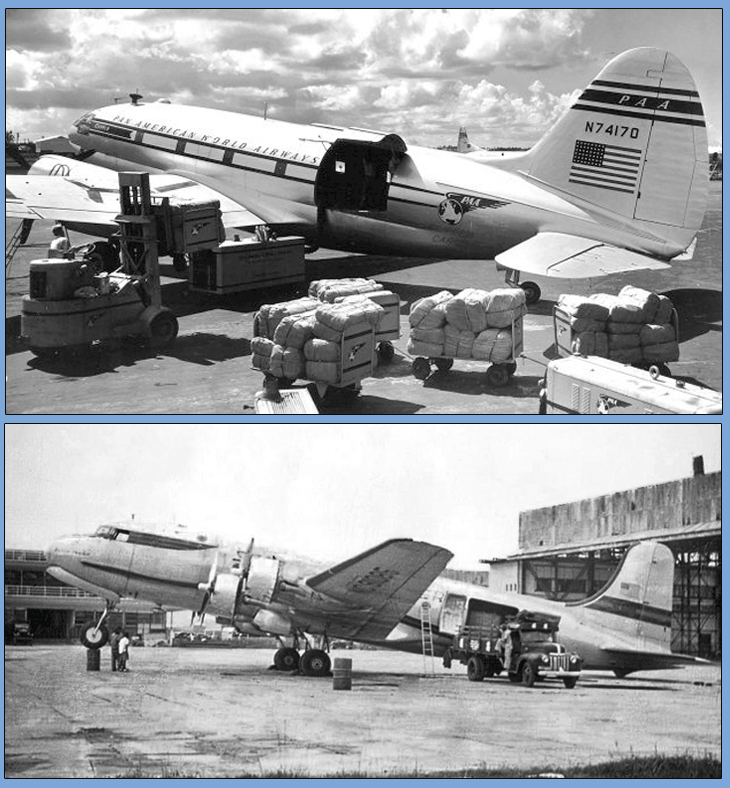
The
other side of the coin—routine
commercial heavylift—was
the exception, far below
the norm. Yet, even in this
budding period of opportunity
there were a handful of
cases that represented a
promise of a great tomorrow.
One massive air shipping
event involved the building
of the Caribe-Hilton hotel
in San Juan, Puerto Rico.
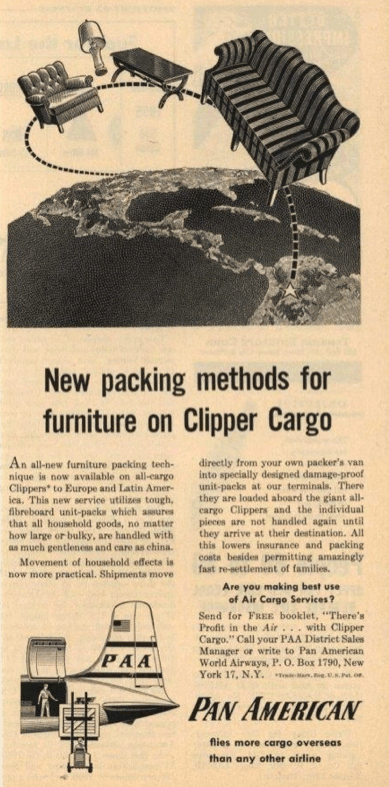 Construction
of the luxury hotel began
shortly after world War
II’s end. Furniture,
because of its bulk, value
per pound, and other factors,
was widely regarded as being
among the low air freight
candidates despite the industry
“facts,” Eastern
Airlines (from Newark and
Chicago) and Pan Am (from
Miami) were engaged to haul
a total of approximately
200,000 pounds of furniture
on some 30 flights. A glance
at the airborne items is
stunning even in the Jet
Era: 600 bed frames, 304
dressers, 352 vanity tables,
3,000 chairs and sofas,
and 355 floor lamps plus
miscellaneous pieces.
Construction
of the luxury hotel began
shortly after world War
II’s end. Furniture,
because of its bulk, value
per pound, and other factors,
was widely regarded as being
among the low air freight
candidates despite the industry
“facts,” Eastern
Airlines (from Newark and
Chicago) and Pan Am (from
Miami) were engaged to haul
a total of approximately
200,000 pounds of furniture
on some 30 flights. A glance
at the airborne items is
stunning even in the Jet
Era: 600 bed frames, 304
dressers, 352 vanity tables,
3,000 chairs and sofas,
and 355 floor lamps plus
miscellaneous pieces.
It
is notable that this deal,
planned years before the
Total Cost Concept came
to broad industry notice,
employed the economics of
TCC. Stacked against the
lower surface transportation
rates, contributing to a
decision for airlift were:
nearly 100 percent elimination
of crating and packing,
warehousing, insurance,
documentation, and transfer
expenses were either slashed
or entirely dropped. Also
vanished were damage and
pilferage, many handling
fees, and deterioration.
There were zero expenses
at the delivery point. An
enlightening postscript
stressed the fact that the
working capital used in
the transaction between
the furniture production
and use was eliminated by
precise timing and scheduling.
The task of the working
capital reached completion
in three weeks less time.
Possibly
the earliest of air freight’s
cheerleaders were marketers
in the field of agriculture.
Theirs was a virtually spontaneous
reaction to premature picking,
substandard ventilation,
troublesome refrigeration,
boxcar diversion, and slow
speeds. It was customary
for growers to pick their
produce at “green-ripe”
stage—i.e., shortly,
before full ripeness was
attained by the time the
produce went on display
at destination. But hold!—there
was a price to pay for this
type of movement. The price:
texture, juiciness, color,
flavor, and full sugar and
vitamin content.
Food-shopper
awareness of vitamin content
was known to be a compelling
level, and many retailers
resorted to posting vitamin
content along with the price
of the product. Eighteen
fresh tomatoes—six
tomatoes in each of three
groups designated Airborne,
Railborne, and, Hothouse-Grown.
These entered tests for
vitamin C content via the
Fisher Titrimeter. Vitamin
C content of the airborne
sample was nearly twice
that of the railborne samples—25.45
versus 14.43, slightly higher
than the hothouse-grown
tomatoes, 13.18.
As
in a single voice, the scheduled
and nonscheduled operators
posed the following question
at a meeting of the United
Fresh Fruit & Vegetable
Association: if the air
carriers were to provide
the capacity and weight,
could shippers of produce
accommodate heavy tonnages?
In response, Claude N. Palmer,
an official of the organization,
came through with a loud
Yes, “provided the
charges for airborne perishables
will have to command over
the surfaceborne.”
He described it as a “challenge
to the ingenuity and fairmindedness”
of the air cargo industry.
Drugs
and medicines are also veteran
oldtimers, along with chemicals
and pharmaceuticals. In
emergency situations, their
dispatch by air swiftly
became a commonplace procedure.
Just a few short months
after the Japanese surrender,
New York City—for
the first time in decades—received
the unwelcome visit of smallpox.
Ill-prepared to combat the
disease on the required
all-out coverage of the
city’s population,
calls for medical aid went
out to sources throughout
the country. With the exception
of local suppliers who utilized
surface transportation modes
for their deliveries, all
other drug companies and
chemical laboratories delivered
their vaccination kits by
air. The epidemic was halted
in its tracks. It was a
perfect example of the difference
between haste and speed:
promptness in placing order,
and speed in delivering
them.
A
report made public by the
Department of Defense in
1950 revealed that the whole
blood flown to Korea in
the Defense Blood Program—it
was implemented by the American
Red Cross—depressed
the mortality rate of the
wounded to slightly above
1 percent as against World
War II’s lowest level
of 2.7 percent.
Leave
it to Herbert Spencer who
advised that the tyranny
of milady is tougher than
any other tyranny we suffer
under—in the instant
case, applied to fashion.
In
the immediate postwar America,
the thought of air travel
was wreathed with a kind
of unique fascination. More
visibly in the field of
women’s fashions,
marketers discovered value
in associating the product
with the romance of air.
Hence, dresses with labels
reading Flown from Hollywood
and Broadway Airborne. There
were international variations
drawn on London and Paris.
If
industry gossip was to be
believed, retailers of fashion
goods anticipated the major
airlines’ cargo marketers
in highlighting dollars-and-cents
values in the careful use
of air freight. Such as
limited initial quantities
of a range of styles to
test buyers’ choices
at the start of a new season;
reliance on the speed of
airborne reorders in precise
quantities of style, color,
and size in order to avoid
full ranges; careful purchasing
through the length of a
season results in fewer
markdowns at season’s
end.
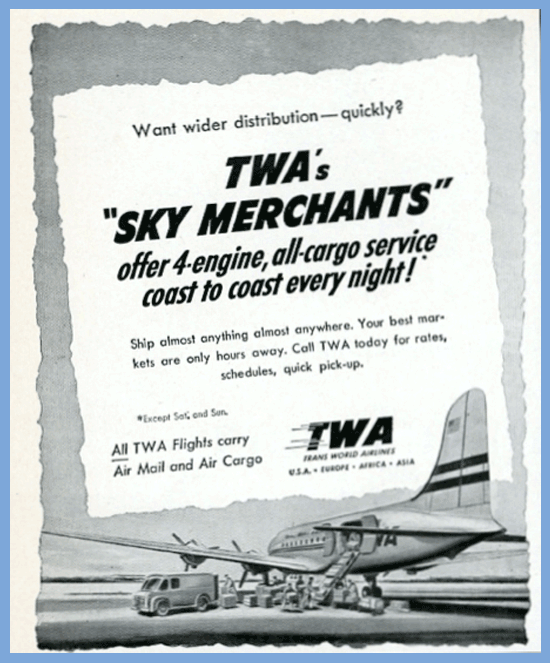 TWA
was authority for a case
involving an import of angora
sweaters from Rome. The
sale and turnover of capital
investment of $10,000 every
four days air delivery time
was four days, compared
with 16 days surface time.
Each turnover produced a
profit of 8 percent, a reduction
of 2 percent. However, the
importer was able to effect
turnover four times as fast.
The original $1,000 net
profit climbed to $3,200—healthy
profits in the Forties.
TWA
was authority for a case
involving an import of angora
sweaters from Rome. The
sale and turnover of capital
investment of $10,000 every
four days air delivery time
was four days, compared
with 16 days surface time.
Each turnover produced a
profit of 8 percent, a reduction
of 2 percent. However, the
importer was able to effect
turnover four times as fast.
The original $1,000 net
profit climbed to $3,200—healthy
profits in the Forties.
Early
in 1946, without fanfare,
International Air Freight,
a so-called GI nonscheduled
airline operating C-47 equipment,
loaded a specially fitted
cargoplane with six bulls
and four heifers. The flight
from New York to Medellin,
Colombia, was technically
unremarkable except for
one solitary fact: it was
the first recorded flight
of a planeload of cattle.
Records,
as the old saying states,
are meant to be broken,
and the industry lost no
time in proving the adage
right: planeloads grew,
tonnages increased, distances
extended. A little more
after the New York—Medellin
record flight, a new high
mark was established by
Pan Am which transported
a full load of pure-bred
Holstein–Friesians
arranged in stalls the entire
length of a DC-4 freighter
from Toronto to Buenos Aires,
a distance of 2,800 miles.
The flight was via Miami,
San Juan, Port of Spain,
Belem, Rio de Janeiro, and
Porto Alegre.
There
was one problem at journey’s
end: the count of cattle
for the takeoff didn’t
match the count on landing—easily
explained by the birth of
a calf on board.
In
direct contradiction of
some published descriptions
of the Air Cargo Age’s
start-up years in terms
of normal (on the whole)
growth, the single purpose
of this report is to dramatize
a brand new industry’s
shattering lunge past mediocrity.
A case in point is the account
of the Toronto–Buenos
Aires cattlelift, which
set a record that lasted
many years.
I
recall vividly an SAS advertisement
of that time, which portrayed
an aircraft with the protruding
neck of a giraffe. The Scandinavian
airline claimed the ability
to transport any kind of
animal with the exception
of the giraffe for the pictured
reason. (Shipments of domestic
pets stowed on all passenger
flights are not considered
in this article.)
Postwar’s
first half-decade was witness
to a dizzying array of safe
animal-transport feats.
Argentine
toads to combat infestation
in the United States; a
complete circus, Florida
to several Latin American
capitals; zoo animals of
every description crossing
the Atlantic and Pacific;
hundreds of Indian monkeys
for scientific research—all,
and more, forming a category
of shipment of increasing
importance. According to
BOAC, in the 18 months prior
to 1950, every tenth passenger
was an animal.
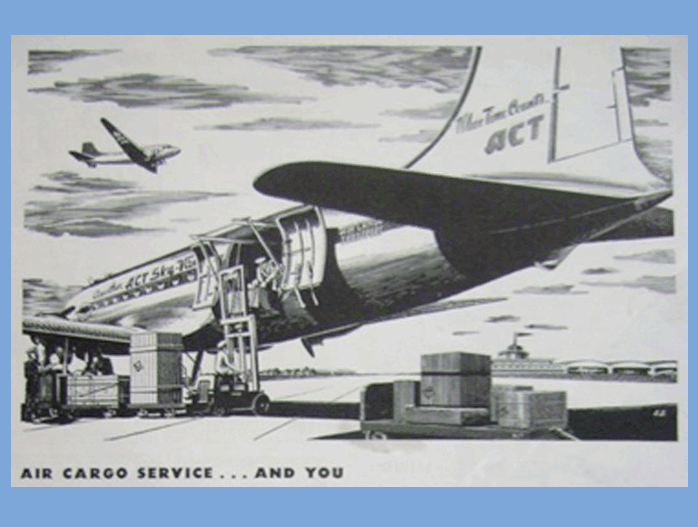
Seven
decades of postwar air freight
history have slipped into
the past, but I still cite
a two-way international
operation as a model for
advancing service objectives.
It began when a tanker owned
by the Standard Vacuum Oil
Co. broke down on a river
near Palembane, Sumatra.
Unable to continue–the
layover cost Standard Vacuum
$4,500 a day—Bethlehem
Steel was wired for a rudderstock
and several crates of replacement
parts plus boiler tubes.
At the airport in New York,
the cargo was loaded aboard
a Seaboard & Western
DC-4 freighter. After touching
down at Gander and Shannon,
it flew on to Brussels,
where a 3,600-pound motor
was loaded intot he plane.
Then on to Rome for refueling,
Athens, Abadan, where the
boiler tubes were offloaded,
Karachi, New Delhi, Bangkok
(where arrangements were
made for a return planeload
to New York), and Singapore.
Two
cranes were required to
withdraw the 16-foot long
rudderstock from the DC-4.
The task was completed in
a couple of hours, and after
an interval the airline
took aboard a 23-foot python
and 100 java monkeys, only
a portion of the return
load. In Bangkok, the New
York-bound load was completed
by four gibbons, two leopards,
and a pair of cobras, and—“wonder
of wonders!”—six
1,350-pound elephants.
Richard
Malkin
Editor's
Note
Richard Malkin
allowed his envisioned first
choice (fiction writing)
of profession to lapse.
At age 102, he is in his
72nd year as an air cargo
journalist. Malkin’s
coverage of The Berlin Airlift
(1948-49) invented modern
air cargo journalism.
For More on
Richard click here.
malkin101@aircargonews.com




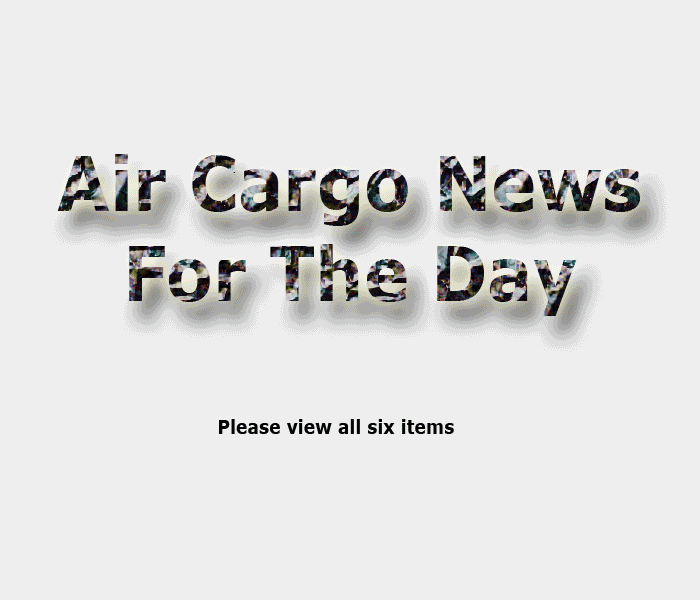

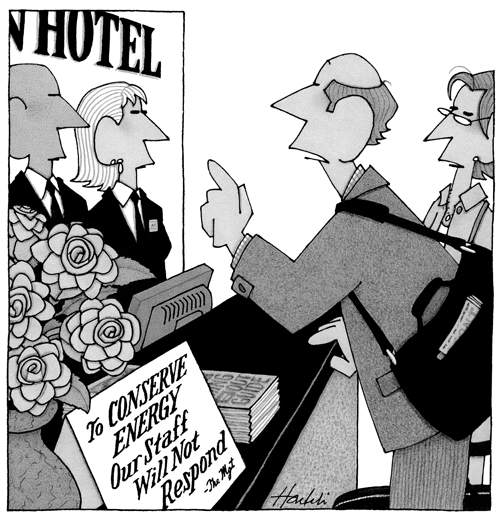


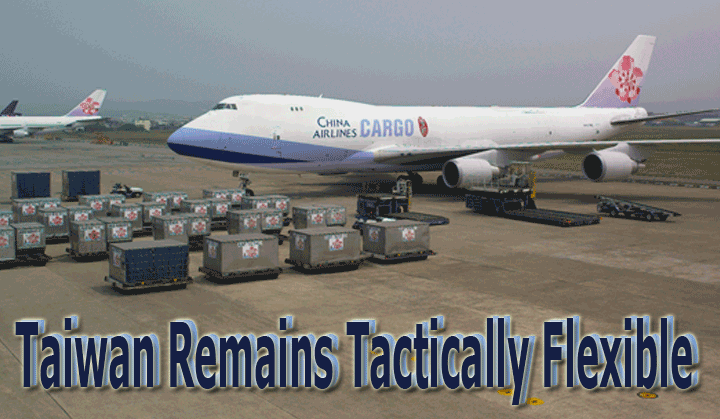



 It is an historical caprice
of fate that the closing
of both world wars were
witness in the earlier instance,
to the carriage of newspapers
and mail aboard the first
scheduled airline flight;
and in the later instance,
the dawning of what came
to be known as the Air Cargo
Age (which gave way to the
Jet Era about a quarter-century
afterward).
It is an historical caprice
of fate that the closing
of both world wars were
witness in the earlier instance,
to the carriage of newspapers
and mail aboard the first
scheduled airline flight;
and in the later instance,
the dawning of what came
to be known as the Air Cargo
Age (which gave way to the
Jet Era about a quarter-century
afterward). There
is the classic case of the
Four Wheel Drive Auto Co.
of Clintonville, Wisconsin,
with an order for a 7,000-pound
truck to be delivered to
a Cairo-based buyer. Per
schedule, the vehicle was
loaded into a railcar destined
for Newark. But a cable
from Cairo informed the
shipper insisted on delivery
no later than 10 days. Decision
on a quantity order depended
on it. Abrupt change of
plan diverted, upon delivery
in Newark, to a barge crossing
the river and then the truck’s
body was detached from the
cab.
There
is the classic case of the
Four Wheel Drive Auto Co.
of Clintonville, Wisconsin,
with an order for a 7,000-pound
truck to be delivered to
a Cairo-based buyer. Per
schedule, the vehicle was
loaded into a railcar destined
for Newark. But a cable
from Cairo informed the
shipper insisted on delivery
no later than 10 days. Decision
on a quantity order depended
on it. Abrupt change of
plan diverted, upon delivery
in Newark, to a barge crossing
the river and then the truck’s
body was detached from the
cab.
 Construction
of the luxury hotel began
shortly after world War
II’s end. Furniture,
because of its bulk, value
per pound, and other factors,
was widely regarded as being
among the low air freight
candidates despite the industry
“facts,” Eastern
Airlines (from Newark and
Chicago) and Pan Am (from
Miami) were engaged to haul
a total of approximately
200,000 pounds of furniture
on some 30 flights. A glance
at the airborne items is
stunning even in the Jet
Era: 600 bed frames, 304
dressers, 352 vanity tables,
3,000 chairs and sofas,
and 355 floor lamps plus
miscellaneous pieces.
Construction
of the luxury hotel began
shortly after world War
II’s end. Furniture,
because of its bulk, value
per pound, and other factors,
was widely regarded as being
among the low air freight
candidates despite the industry
“facts,” Eastern
Airlines (from Newark and
Chicago) and Pan Am (from
Miami) were engaged to haul
a total of approximately
200,000 pounds of furniture
on some 30 flights. A glance
at the airborne items is
stunning even in the Jet
Era: 600 bed frames, 304
dressers, 352 vanity tables,
3,000 chairs and sofas,
and 355 floor lamps plus
miscellaneous pieces.  TWA
was authority for a case
involving an import of angora
sweaters from Rome. The
sale and turnover of capital
investment of $10,000 every
four days air delivery time
was four days, compared
with 16 days surface time.
Each turnover produced a
profit of 8 percent, a reduction
of 2 percent. However, the
importer was able to effect
turnover four times as fast.
The original $1,000 net
profit climbed to $3,200—healthy
profits in the Forties.
TWA
was authority for a case
involving an import of angora
sweaters from Rome. The
sale and turnover of capital
investment of $10,000 every
four days air delivery time
was four days, compared
with 16 days surface time.
Each turnover produced a
profit of 8 percent, a reduction
of 2 percent. However, the
importer was able to effect
turnover four times as fast.
The original $1,000 net
profit climbed to $3,200—healthy
profits in the Forties.


